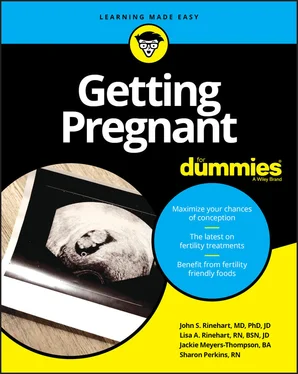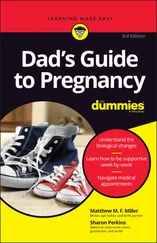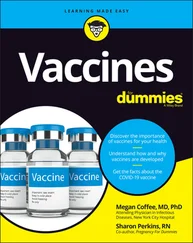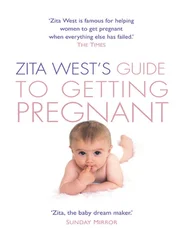Conceiving a Baby: How Sex Should Work
The time is right, the moon is bright, and it’s time to get pregnant. Here’s what needs to happen:
1 It’s near ovulation; an egg is about to release from its follicle.
2 You and your partner become aroused. Your vagina produces secretions that make it easier for the now erect penis to enter the vagina.
3 During the man’s orgasm, several million sperm are forcefully ejaculated into the vagina. As they pass through the cervix into the uterus, the cervical mucus “filters” the sperm so that they’re ready to penetrate an egg.
4 Your egg releases from the follicle and enters one of your fallopian tubes.
5 The sperm swim through the uterus up to the fallopian tubes.
6 The next day your egg meets up with several hundred sperm in the fallopian tube, and the sperm all attach themselves to the egg.
7 One sperm breaks through the outer layer of the egg causing a chemical reaction that makes the egg immediately impenetrable to the rest of the sperm.
8 The genetic material of the egg and sperm combine, and the newly created embryo is moved down the fallopian tube to the uterus. Cells which line the inside of the tube have hair-like projections and create a wave, much like moving a beach ball in the crowd at a football game. The embryo remains in the tube for a couple of days where is develops and then is moved into the uterus. So the tube is both a transporter and an incubator for the developing embryo.
9 The embryo implants in the uterine wall and grows, and you miss your period.
10 You’re pregnant! Congratulations.
 There is no “best” position for making babies.While some “helpful” books, articles, blogs, and even healthcare providers may tell you that lying on your back for a while or elevating your hips after sex will help you get pregnant, doing so isn’t necessary. Similarly, you may have heard that certain sexual positions may work better than others — not so much. You can choose whatever position during or after sex that is right for you and your partner.
There is no “best” position for making babies.While some “helpful” books, articles, blogs, and even healthcare providers may tell you that lying on your back for a while or elevating your hips after sex will help you get pregnant, doing so isn’t necessary. Similarly, you may have heard that certain sexual positions may work better than others — not so much. You can choose whatever position during or after sex that is right for you and your partner.
Figuring Out How Often to Have Sex
When you’re trying to get pregnant, it is important to have intercourse every other day. It is a myth that you can have too much sex. Increased ejaculation may make the sperm count lower, but it does not decrease pregnancy rates. In fact, some men with low counts actually increase the amount of sperm they ejaculate with more frequent ejaculations.
When you’re close to ovulating, have sex at least every other day; every day is okay. Most doctors recommend the two days before and the day you ovulate as the best time for conception. Other than that, timing should remain routine so that there are no prolonged periods of abstinence. Infertility can severely decrease the joy of sex and the intimacy that usually accompanies intercourse. Don’t drive yourself crazy with things that don’t matter.
Chapter 3
Blame It on My Genes! The Role of Genetics and Family History
IN THIS CHAPTER
 Understanding how your genes work
Understanding how your genes work
 Explaining what diseases can be inherited — including infertility
Explaining what diseases can be inherited — including infertility
 Knowing how family history can help you find out about yourself
Knowing how family history can help you find out about yourself
 Finding out what’s in your genes
Finding out what’s in your genes
Nothing is more popular around the dinner table than crediting or blaming your family for who you are. You are so good at math — just like your dad. You sing like a dream — just like your mom. Always late like your Aunt Ellen! Grandma’s eyes, Grandpa’s hair, Aunt Susie’s wit, Uncle Bert’s moods … and your sister’s funny little toe can all be found in you, and it must be because of your genes. But how exactly do genes work, and why are they important if you are trying to have a baby?
Genetics has become a very popular word. With that popularity has come myth and misunderstanding. But the concept of the field of genetics is really quite simple. Genetics deals with the instruction manual on how to build a human. To be exact, a Google search gave the definition of genetics as “the study of heredity and the variation of inherited characteristics.”
 One analogy is to view the instructions on how to build a human as a book, passed on from generation to generation, which is called inherited. The book is divided into chapters called chromosomes. The chapters have paragraphs called genes, and the words are made from a very simple alphabet. And just in case you are feeling special, the majority of the book, (99 percent) has the same chapters as the manual for building a chimpanzee. Also, the person you think is, well, “different,” actually has the same 99.9 percent of your genetic code. Reassuringly, given the size of the genetic code, that is still over three million differences.
One analogy is to view the instructions on how to build a human as a book, passed on from generation to generation, which is called inherited. The book is divided into chapters called chromosomes. The chapters have paragraphs called genes, and the words are made from a very simple alphabet. And just in case you are feeling special, the majority of the book, (99 percent) has the same chapters as the manual for building a chimpanzee. Also, the person you think is, well, “different,” actually has the same 99.9 percent of your genetic code. Reassuringly, given the size of the genetic code, that is still over three million differences.
 The estimate is that the human genetic code has over 3 billion units, which is huge, but the lowly Amoeba dubia has over 670 billion units. So, it really is not how you say it but what you say that matters.
The estimate is that the human genetic code has over 3 billion units, which is huge, but the lowly Amoeba dubia has over 670 billion units. So, it really is not how you say it but what you say that matters.
What are genes and chromosomes?
Genes are a long string of four chemicals called nucleotides and lettered as A (adenine), C (cytosine), G (guanine), and T (thymine). Words in the code are made from just these four chemicals, and the alphabet has only four letters. That’s really a small alphabet to create a person. The English alphabet has 26 letters, and if you limit the number of syllables a word could have to 14, over 2.75963 x 10 7words are possible. Fortunately for those spelling whizzes, the English language has only a little over 200,000 words.
The genetic code has only four letters, and the words (codons) can be only three letters long, so at most 64 possible combinations are used for the genetic code. The directions for building a human, the genetic code, is a string of three-letter words. However, the string is not one continuous string but rather 23 strings of code. These 23 separated strings are called chromosomes (see Figure 3-1). Each time a cell wants to divide, it must accurately create two copies of the genetic code, and it does this one word (codon) at a time.
To complicate this even further, a person inherits one set of chromosomes from each parent so that each cell has two copies of each chromosome. Thus, inheritance is a demanding task of accurately repeating the copying of the code over and over to create the 37 trillion or so cells that make a human.
Genes are used to direct a cell to make proteins. Proteins are strings of molecules called amino acids, and there are 20 that are used to make proteins. Proteins are the workhorse of constructing a human. The DNA uses a different type of genetic material called RNA to assemble proteins from the amino acids. Each gene determines which amino acids are to be used and in what sequence. The way in which the amino acids are strung together determines the three-dimensional structure of the protein.
Читать дальше

 There is no “best” position for making babies.While some “helpful” books, articles, blogs, and even healthcare providers may tell you that lying on your back for a while or elevating your hips after sex will help you get pregnant, doing so isn’t necessary. Similarly, you may have heard that certain sexual positions may work better than others — not so much. You can choose whatever position during or after sex that is right for you and your partner.
There is no “best” position for making babies.While some “helpful” books, articles, blogs, and even healthcare providers may tell you that lying on your back for a while or elevating your hips after sex will help you get pregnant, doing so isn’t necessary. Similarly, you may have heard that certain sexual positions may work better than others — not so much. You can choose whatever position during or after sex that is right for you and your partner. Understanding how your genes work
Understanding how your genes work The estimate is that the human genetic code has over 3 billion units, which is huge, but the lowly Amoeba dubia has over 670 billion units. So, it really is not how you say it but what you say that matters.
The estimate is that the human genetic code has over 3 billion units, which is huge, but the lowly Amoeba dubia has over 670 billion units. So, it really is not how you say it but what you say that matters.










